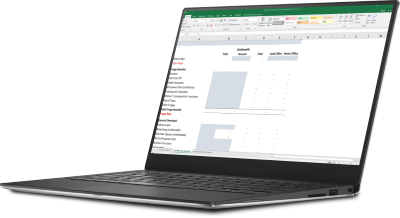If you’re a government contractor and a potential client asked you to fill a position, could you give them a rough price on the spot? What would you charge for that position? What if a fellow contractor who wants to team with you on a proposal asked, “What is your wrap rate?”
Just like building a house, laying the foundation may seem like a simple part of the overall construction process, but it’s the most important part of the entire project and in government contracting, it starts with the chart of accounts.
Accurate Rates Start with a Strong Chart of Accounts
Being DCAA compliant is vital for a government contractor and having the chart of accounts set up properly allows you to begin the whole process the right way.
This will enable you to compare prior periods, determine trends (good and bad) and be prepared with accurate pricing data to ensure that you are billing what you should be on pricing proposals. Most importantly, it helps you avoid putting your company in a losing position, locked into a rate that is below your costs, thereby driving losses on a contract you might have for many years.
By correctly establishing your accounting system’s chart of accounts, you can ensure a compliant, accurate and informative construct to manage your wrap rate at any time during the year.
How Are Costs Categorized?
It’s important to understand the “buckets” in which costs fall:
Direct Costs
These are costs that can easily be identified and connected to the “direct” delivery of production for a specific contract or project. Direct costs include direct labor, direct subcontractors, direct travel and direct materials, just to name a few.
Indirect Costs, Also Called “Burdens”
These are costs that cannot easily be identified and connected to a specific contract or project. As defined by the U.S. Office of Management and Budget, these are costs that have been incurred for common or joint objectives and cannot be readily identified with a particular final cost objective.
There are three different “pools” into which indirect costs fall: fringe benefits, overhead, and general and administrative (G&A) costs. Examples of each pool are described in more detail below.
Unallowable Costs
These are costs that the government does not reimburse for, such as certain entertainment and lobbying efforts. Examples include alcohol, certain business development efforts and marketing expenses. These are described in federal acquisition regulation (FAR) 31. You can read more about unallowable costs in our Quick Guide: Unallowable Costs in Government Contracts.
These cost buckets are important because they capture where your costs get allocated, ensuring that your rates and analysis of contracts are done correctly.
Why Knowing Your Indirect Costs Is So Important
Your indirect cost pools of your chart of accounts can be small or large depending on your company’s structure, size and spending priorities. We recommend to our government contractor clients that they routinely analyze each section of the indirect cost pools to (a) determine where expenses are causing issues in their overall operations and profitability and (b) compare their pricing to competitors’ pricing based on the rates of each pool.
Additionally, having a well-managed chart of accounts can simplify your annual budgeting processes — or in many cases, enable you to create one.
Some of the specifics of each indirect cost pool are as follows:
Fringe Benefits
These costs generally relate to your employees and include items such as payroll taxes, health insurance, vacation and holiday costs, and retirement and 401(k) plan contributions.
Overhead Costs
These are costs needed or used to support contracts or projects that aren’t easily identifiable to a specific one. Overhead costs include items such as allocation of salary costs for project managers, training costs and facility costs.
Download our free overhead rate calculator here.
General and Administrative (G&A) Costs
These are costs that are necessary for operating the business. Examples include human resource costs, legal and accounting, and rental space for the corporate office.
What Is a Wrap Rate and Why Is It Important?
When these items are set up properly, you’re able to develop your wrap rates, which include “fee,” which is profit. Fee percentages in the government contracting space are generally in the 5-10% range.
Understanding what a wrap rate is used for is critical. Your wrap rate allows you to assess what you need to recover costs used to pay your employees, enable fringe benefit offerings to retain your workforce, and account for your overhead and G&A costs to deliver high-quality products and services to your clients.
You can develop more granular wrap rates for work being done onsite or offsite, as your overall costs could be different depending on where the work is being done, and costs you must take on depending on the location.
Monitoring your rates routinely is extremely important to ensure that financial decisions aren’t being made without taking possible new costs into consideration. Rates are fluid just like your monthly financials and are just as important when it comes to looking at new work. But ultimately, these rates are only able to be analyzed and reviewed correctly with an effective chart of accounts within your accounting system. This is why it’s so important to set up your chart of accounts correctly early on.
Need Help?
As you can see, there are many complexities to developing your bid rates and allocating costs to each cost pool. Setting this up in the initial stage of the process is crucial to having a sound foundation to build your financial and operational success and to provide you with confidence in your overall operations.
If you need help establishing your chart of accounts, wherever you are in the process, or are looking for an assessment, our Government Contractors Group can help. Contact us here or call 800.899.4623.


